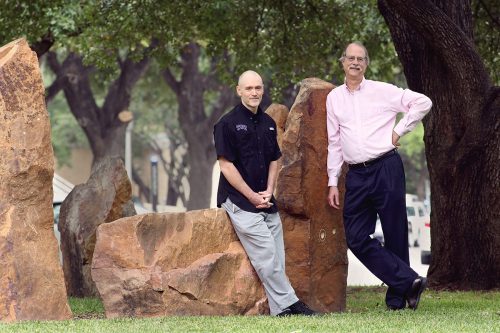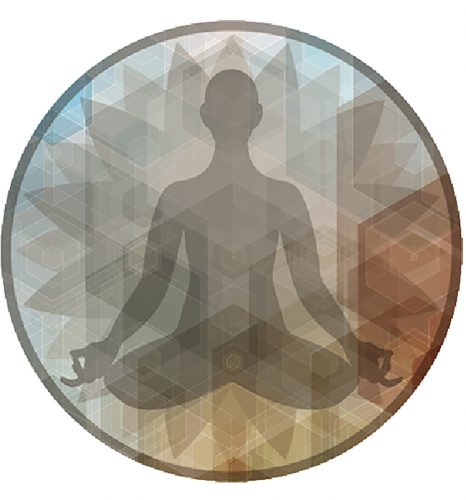Practice Mindfulness for Less Stress and Better Sleep
Students and faculty go with the flow of meditation and mindfulness.
Practice Mindfulness for Less Stress and Better Sleep
Students and faculty go with the flow of meditation and mindfulness.
From combating stress to improving sleep, the practice of mindfulness is increasingly accepted in Western culture as a way to foster well-being. On college campuses, the emerging field of contemplative studies offers a pathway to mindfulness through introspective activities such as meditation and dance.
At TCU, a faculty interest group was formed in 2011. Today the group encompasses professors from engineering, business, physics and other fields seeking to enhance their personal practices while expanding student understanding of mindfulness.
“Many of our students face stress, anxiety and depression, and would benefit from meditative practices, but [the students] say they’re too busy,” said Mark Dennis, associate professor of religion, who leads the group. “And while meditation is generally seen as a seated practice, mindfulness can become part of our daily lives through focusing on breathing or even simply walking.”

Mark Dennis, left, and Andrew Fort participate in a faculty mindfulness group at TCU. Photo by Carolyn Cruz
Andrew Fort, who retired as professor of religion in 2016 and is now the Cecil and Ida Green Distinguished Emeritus Tutor, defines mindfulness as “focusing awareness on the present moment and watching the mental flow without judgment.” The noted Hindu scholar has meditated daily for more than four decades.
“For years, Mark Dennis and I included a weeklong mindfulness meditation exercise in our Buddhism courses,” Fort said. “In addition to integrating contemplative exercises in their own classes, steering committee members also led exercises in other faculty members’ classes — from business to philosophy to media ethics.”
Dennis, who specializes in East Asian religions, teaches an honors colloquium, “Mindfulness and Millennials,” at TCU. “One of the requirements is that students engage in meditation and other practices for the entire semester,” said the professor, who studied yoga and meditation during the eight years he lived in India and Japan.
Dave Aftandilian, associate professor of anthropology, assigned meditation/contemplative practices in several of his courses, including one called “Anthropological Approaches to Nature and the Sacred.”
“In part I want students to have a chance to practice how [indigenous] peoples have traditionally come to know nature, which is primarily through direct personal experience,” Aftandilian said. “And in part I just want them to get outside to experience ‘aha’ moments of personal connection with the natural world that I hope will stay with them long after they left my classroom.”
In terms of contemplative practices, Fort said a one-size-fits-all approach rarely works. “There is a big smorgasbord of things you can do, and virtually everyone can find something that works for them, but people do have to search for their thing.”

Getty Images © PINGWIN
In 2016 and 2017, John Dunne, the first distinguished chair in contemplative humanities at the University of Wisconsin-Madison, gave lectures at TCU on contemplation and neuroscience and the combination’s role in higher education.
“Afterward, we brought him together with representatives of the emerging medical school,” Fort said. “There is increased value on mind-body relationships in the field of health care, where we’ve seen a rise in meditative practices related to pain relief and managing stress.”
Fort hopes to see more undergraduate classes similar to “Mindbodyness: Contemplative Movement and Reflection.” He taught the class in 2015 with Susan Douglas Roberts, professor of dance. The two professors divided class time between contemplative movement practice and communication in the form of journaling, discussions and lectures. The students also participated in a day of silence.
“They especially valued learning what guest teacher Alejandro Chaoul [director of education for the Integrative Medicine Program at the University of Texas MD Anderson Cancer Center] called meditation pills, tools to quiet and center themselves during the daily rush of university life,” Fort said. “There was a striking emphasis on how much they welcomed and integrated simple and practical self-care skills of focused breathing and being present.”

Your comments are welcome
Comments
Related reading:
Research + Discovery
Kristen Carr Studies Coping through Communication
A sympathetic ear can support healing after a stressful event.
Research + Discovery
Greed and the Company’s Bottom Line
Study finds that too much greed and too much generosity can both hurt a company’s bottom line.
Campus News: Alma Matters
Yoga for Musicians
Music majors learn to improve focus, build strength and relax.